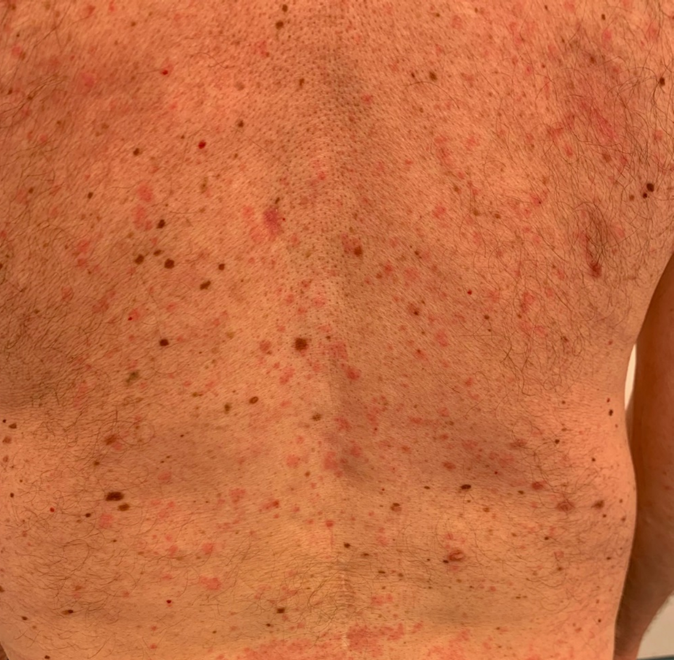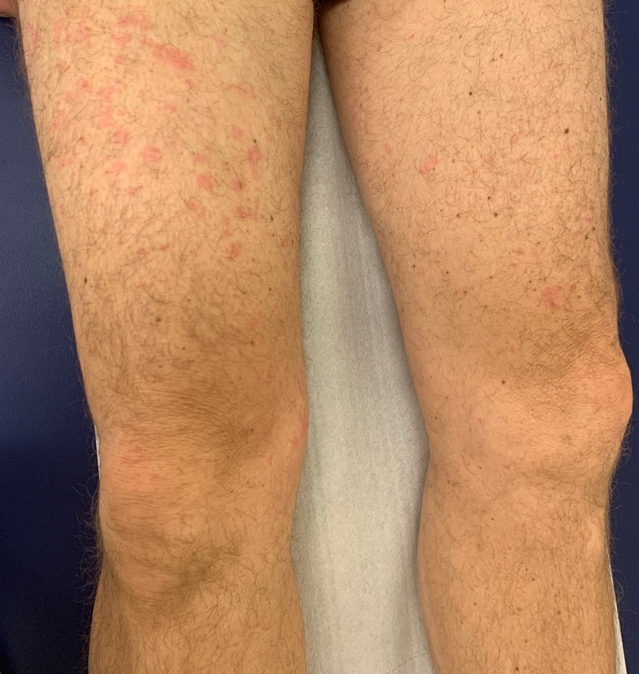Case Presentation: Schnitzler syndrome (SD) is a rare auto-inflammatory disease where patients present with recurrent fevers, arthralgias, urticaria, monoclonal gammopathy and elevated inflammatory markers. It was first described by Liliane Schnitzler in 1972 [1]. Given the complexity and rarity of this syndrome it is often underdiagnosed and causes a significant delay between disease onset and diagnosis [2]. A 61-year-old male with history of gout presented with migratory arthralgias associated with joint swelling, non-pruritic rash and morning stiffness of 2 years. Given the duration and unknown cause of his symptoms, Rheumatology was consulted. He complained of fatigue, night sweats, fevers and weight loss over the same period. He denied any significant family history. On exam he appeared healthy, but had an urticarial rash affecting his entire trunk and bilateral lower extremities. His exam was negative for lymphadenopathy (LAD), arthritic changes, or limited range of motion in major joints. His labs showed elevated CRP of 46 mg/L, ESR of 39 mm/h, ferritin 357 mcg/L, M-protein IgG lambda 8.4 g/L; normal corrected Ca, Cr, liver panel, free light chain ratio, ACE level, CBC and urinalysis. Negative serology for ANA, anti-dsDNA, IgM RF and anti-CCP. Infectious work-up was also negative for Lyme, Hep B and C virus, Syphilis, EBV and TB. Skin biopsy revealed perivascular lymphohistiocytosis with neutrophils, consistent with urticaria. Abdominal ultrasound was negative for LAD or organomegaly, and chest x-ray was normal. PET scan did not show any focus of infection, inflammation or LAD.Lupus was excluded given the negative ANA and anti-dsDNA. The other differential hypocomplementemic urticarial vasculitis syndrome (HUVS) was excluded given lack of glomerulonephritis, uveitis, and negative ANA. Angioedema and COPD were ruled out as well. Infectious etiology was unlikely given negative work-up. The differential diagnosis was then narrowed down to autoinflammatory etiologies, however, adult onset Still’s disease (AOSD) was not consistent given the low ferritin and no other symptoms supporting AOSD; Cryopyrin-associated autoinflammatory syndromes (CAPS) was ruled out given age [3]; SD was the most consistent given the patient had chronic urticaria and associated monoclonal gammopathy.
Discussion: The patient fulfilled the Strasbourg diagnostic criteria [2], by having chronic urticarial rash, monoclonal IgG, recurrent fevers and elevated CRP making the diagnosis SD definite. The pathophysiology of this syndrome is not fully understood, however IL-1 has been reported to have crucial role causing abnormal cytokine regulation [4]. Koning et al reported in their case series somatic mosaicism of NLRP3 mutations in the myeloid lineage [5]. SD has been linked to AA amyloidosis, sensorimotor neuropathy and lymphoproliferative malignancies [6]. Historically, treatment options included Colchicine and corticosteroids. More recently IL-1 antagonists are used with overall good response, with Tocilizumab as an alternative if IL-1 antagonists are ineffective.
Conclusions: Our patient was initially treated with Colchicine, with resolution of his urticaria, however his pain, night sweats and fevers persisted. An IL-1 antagonist was added, after which his remaining symptoms resolved within few days, with normalization of his inflammatory markers, within five months.


